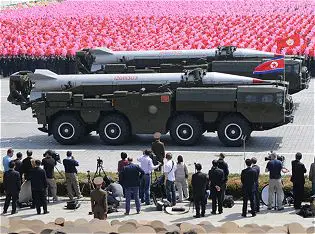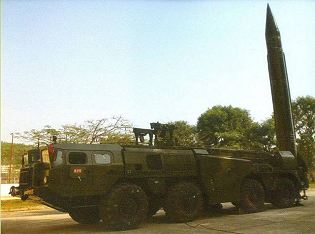| The Hwasong-5 is a surface-to-surface short-range tactical ballistic missile derived from the Soviet R-17 Elbrus missile and based on the Russian-made ballistic missile Scud-B. The first missile prototypes were completed in 1984. Designated Hwasong-5, and known in the West as the "Scud Mod. B". The first test flights occurred in April 1984, but the first version saw only limited production, and no operational deployment, as its purpose was only to validate the production process. Production of the latest version of the Hwasong-5 began at a slow rate in 1985. The North Koreans have built an estimated total of 300 ‘Scud B’ missiles as well as the mobile launch systems, ending production in 1991 or 1992. A 2006 US report estimated the total number of ‘Scud B,’ ‘Scud C,’ and ‘Scud D’ missiles around 600. In 1985, Iran acquired 90 to 100 Hwasong-5 missiles from North Korea in a deal worth US$500M. As part of the deal, North Korea agreed on a missile technology transfer, and it helped Iran establish a production line. In Iran, the Hwasong-5 was produced as the Shahab-1. |
| Launcher unit |
|
The missile is carried on an 8x8 truck similar to the Russian-made MAZ-543. The missile is raised to the vertical position at the back of the TEL (Transporter Erector Launcher) before launch. The use of a cross-country wheeled vehicle gave this missile system greater road mobility, reduces the number of support vehicles required, and still preserves a great choice in selecting off-road firing positions.
|
| Missile |
|
The R-17 ‘Scud B’ was an upgrade over the ‘Scud A’ that became operational in 1962. The missile is 11.25 m long, 0.88 m in diameter, and has a launch weight of 5,900 kg. It has a range of 300 km with an accuracy of 450 m CEP. Several different warheads were developed for the ‘Scud B’ missiles including nuclear yields between 5 and 70 kT, chemical agents, and conventional high explosive. A typical ‘Scud B’ takes approximately one hour to finish a single launch sequence. The North Korean Hwasong-5 liquid propellant ballistic missile has a length of 10.94 m, a diameter of 0.88 m, and a launch weight of 5,860 kg. Its payload carries a single warhead that can either be 985 kg HE, chemical or submunitions. It has a range of 300 km maximum with an accuracy of 450 m CEP.
|
| Guidance system |
|
The Hwasong-5 missile featured an improved inertial guidance system, possibly incorporating active radar terminal homing.
|
| Combat use |
|
The Hwasong-5 has built-in test equipment, can aim the missile, and can fire autonomously if required. However, the target selection and firing is usually carried out from a separate command and control vehicle. A typical `Hwasong-5' launch sequence takes about 1 hour. After launch, the TEL moves to a new position to avoid a counterattack and is reloaded from a towed resupply trailer. The TEL can carry three crew, but it is believed that five men are required in the launcher crew. The Hwasong-5 is designed to strike at targets such as marshaling areas, major storage dumps and airfields behind enemy lines.
|
| |
| Specifications |
| Back to top |
|
Type of missile
|
|
short-range ballistic missile
|
|
Country users
|
|
North Korea, Iran
|
|
Launcher
|
|
mobile truck transporter - erector - launcher
|
|
Warhead
|
|
chemical, conventional HE, submunitions
|
|
Crew
|
|
5 maximum
|
|
|
Vehicle weight
|
|
? kg
|
|
Effective range
|
|
300 km. maximum
|
|
Accuracy
|
|
450 CEP
|
|
Guidance
|
|
Inertial system
|
|
Dimensions vehicle
|
|
Length, 11,24 m; Width, 3.05 m; Height, 2.67 m
|
|
|
| |
|






























